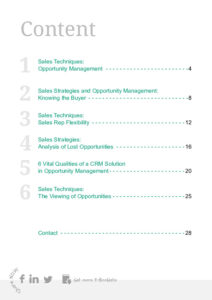Qualifying a lead might be a relatively simple task, but opportunity management is a bit more complex. Why? The stakes are higher: a salesperson is now going to invest valuable time into working the opportunity. It has the real potential of becoming what everyone in the sales force is after: a closed sale.
Everyone is betting that this opportunity will pay off, but there is always that risk factor. Not all sales close. Will this one turn to profit, or become expensively wasted effort? How can the odds be improved in favor of your sales force and your company?
The essential key to opportunity management is accurately evaluating the risk factors. That is, knowing all about your target prospect company—at the very least understanding the industry and how most companies within it operate. Knowing which employees within a company are vital to engage as part of the selling process; having an understanding of your target company’s buying process; and of course knowing all the qualifying questions to ask before you invest serious time and effort.
Chapter 1: Sales Techniques – Opportunity Management
Qualifying a lead is relatively simple. Opportunity management, however, is a bit more complex. The stakes are higher: a salesperson is now going to invest valuable time into working the opportunity, engaging key people at the target company, making presentations, and utilizing all possible sales techniques.
Chapter 2: Sales Strategies and Opportunity Management: Knowing the Buyer
The key component of all sales strategies is opportunity management. And the key element of opportunity management is evaluating risk—having as much information as possible to outweigh the possibility of the sale becoming a loss.
Chapter 3: Sales Techniques: Sales Rep Flexibility
The time has come to let salespeople utilize their “on the ground” judgment and sales techniques when it comes to making various decisions about opportunity management. Selling today requires flexibility, judgment, and a focus on results—not process.
Chapter 4: Sales Strategies: Analysis of Lost Opportunities
If sales management or even members of the sales force can statistically analyze past losses as part of opportunity management, such analysis can yield plentiful data that is helpful to the creation of new sales strategies, helpful to the improvement of closing ratios and helpful to taking time out of sales cycles.
Chapter 5: 6 Vital Qualities of a CRM Solution in Opportunity Management
A CRM solution is crucial both to the operation of a sales force and, factually, of a business itself. But as a sale travels further up the pipeline, the precision of that CRM application increases in importance. By the time you’re well into opportunity management—that stage of a sale in which a sales rep is heavily engaged—your CRM solution had better be fully supportive or you run the risk of losing those opportunities.
Chapter 6 Sales Techniques: The Viewing of Opportunities
While the handling of sales opportunities is a technical subject that we explore in some detail, there is an underlying factor that affects any salesperson’s opportunity management: the way an opportunity is viewed.
Download our ebook Opportunity Management now.

































Comments